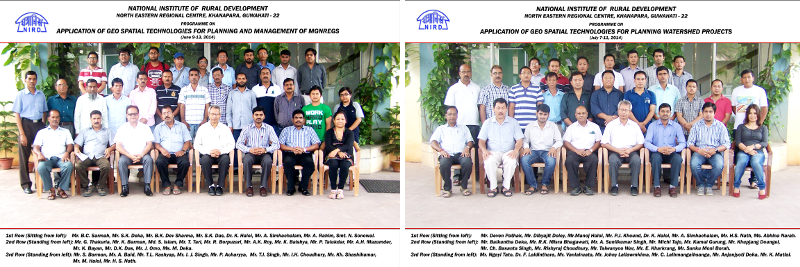Trainings & Research activities using QGIS at NIRD&PR-NERC, Guwahati, India¶
The National Institute of Rural Development & Panchayati Raj (NIRD&PR) is an Apex institute of Ministry of Rural Development, Government of India. Headquarter is located at Hyderabad city of India and it has three sub centres at Guwahati, Jaipur and Patna city. Guwahati is capital of Assam State (North Eastern side of country). The NIRD Guwahati Centre is actively involved in short (mostly 5 days including one-day handheld GPS survey) residential GIS trainings for State, District and Block level government officials of eight North-East Indian States. Apart from government officials, University faculties, College lecturers, research scholars and Reputed NGOs are also trained. Trainings are fully sponsored by NIRD and participants are to bear only their travel expenses. The author is working in NIRD Guwahati centre as an Adjunct Faculty (GIS) and coordinating GIS and Rural Development related trainings at the centre along with Dr. K. Haloi, Training & Research coordinator, i/c Head, C-GARD, NIRD&PR-NERC.
Initially I was involved in conducting GIS trainings with commercial software like ArcGIS and ERDAS. But end of the training programme, participants were not happy due to unavailable of software with them for practice. Then we find the solution with introducing QGIS. After introducing the QuantumGIS, it was felt that the Open Source GIS can fulfil the need of Rural Development sector of India. Accordingly it was introduced in research activities to prepare a base maps like roads, drainage, settlements, delineation of watershed boundary etc. and also to prepare a GPS data downloading, analysis, hyperlinking the field photos of GPS survey etc. Using Google earth plugin we have been introduced to prepare a LULC maps.
Software was then pursued for the personal use for one year and its new versions were checked for the enhanced functionalities. During this whenever author was course coordinator in training, he used QGIS in trainings for introduction and feedbacks.
QGIS is being used in GIS trainings at the centre. Further it is being messaged and advised in all trainings that no commercial GIS software should be purchased at District (administrative unit in India after Nation and State) and below, if real requirement is not felt and this saving may be used for purchase of hardware like GPSs, computers etc. In the training we have been introduced to participants Georeferencing, database creation, digitization, editing, analysis and print composer etc. After introducing QGIS, we are getting good feedback from various officials and students.
There is a question why QGIS only when other software like uDig, MapWindow, gvSIG, GRASS are also there. The answer lies in the facts that QGIS is an OSGeo incubated project, less complex, its development is very fast and associated with huge community of users and developers and lastly authors expertise. With its latest version of 2.4, software is capable of satisfying the all needs of grass root rural development executors in India with satisfying the present queries and wishes for future.
The applications of software during training are generally concentrated on Resource Mapping, Rural infrastructure facility mapping, Watershed and Mahatma Gandhi National Rural Employment Guarantee Scheme (MGNREGS). Watershed and MGNREGS are land based flagships of Government of India. Local Open Source Raster and Vector data are used in exercises. Participants are encouraged to come with their own or departmental data if available to work. Training is provided in lab equipped with 22 computers of i7, 4GB RAM and Windows8 OS. Per training programme number of trainees remains between 20-30.

Training course at NIRD&PR-NERC, Guwahati¶
Conducted QGIS training courses and participants¶
General topics covered are basic introduction to the GIS and QGIS software , major tool bars, plug-in structure, geo-referencing, creation/editing of vector data, clip (Raster/Vector), merge, terrain analysis, contours, .csv to .shp layer, .shp to .kml and vice versa, handling GPS data, Interpolation, table editing/query, field calculator, print composer etc. and some basic analysis on vector data. Apart from introduction to various help links available, a LinkedIn group for participants has been created for post training support. Besides, QGIS based training programmes, QGIS also used in research like georeferncing the maps, database creation, extraction of vector data from toposheets and google earth, editing and analysis, GPS data downloading and process and then layout preparation etc.
Success¶
Every month training is conducted with 20-30 participants, so this number is increasing every month. Training feedbacks are remaining very positive and encouraging. Certificates are provided to the participants after completion of training. Presently handouts are being supplied to the participants in hard copy and tutorial, software and practice data in soft copies but plan is there to create DVDs containing screen-recorded lectures/demo of various topics in English. In future certificate and diploma programmes may also be initiated.
